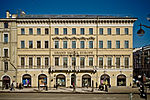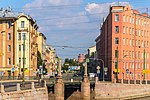Nevsky Prospekt (Saint Petersburg Metro)

Nevsky Prospekt (Russian: Не́вский проспе́кт) is a station on the Moskovsko-Petrogradskaya Line of the Saint Petersburg Metro. It serves the street of the same name, one of the largest in the city. The station was opened on July 1, 1963. While the station itself was designed by Mayofis and Maximov, the interior was designed by Getskin, Shuvalova and Andreyev. The station has two sets of exits on Mikhailovskya Street. The station is linked to Gostiny Dvor via a transfer corridor that descends to the middle of the platform and a set of escalators at the platform's northern end. Nevsky Prospekt is considered one of the most congested stations in the entire Saint Petersburg Metro.Nevsky Prospekt is one of the more exotic locations used in Mornington Crescent, a game played in the BBC Radio 4 show I'm Sorry I Haven't a Clue.
Excerpt from the Wikipedia article Nevsky Prospekt (Saint Petersburg Metro) (License: CC BY-SA 3.0, Authors, Images).Nevsky Prospekt (Saint Petersburg Metro)
Nevsky prospect, Saint Petersburg Apraksin Dvor (округ № 78)
Geographical coordinates (GPS) Address Nearby Places Show on map
Geographical coordinates (GPS)
| Latitude | Longitude |
|---|---|
| N 59.935 ° | E 30.328333333333 ° |
Address
Детский сад № 32
Nevsky prospect
191186 Saint Petersburg, Apraksin Dvor (округ № 78)
Saint Petersburg, Russia
Open on Google Maps











